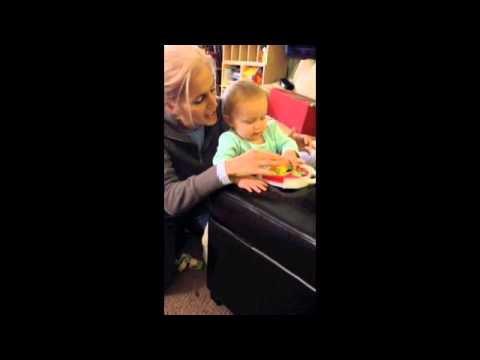You have read all the baby books, talked to other mothers, and scoured the internet. How many times do you do this and then sit down, exhausted at the end of the day and realize that you didn’t have time to do any of it?
Let’s rethink it all.
First, you can use every time you interact with your baby, whether you are carrying her, feeding her, bathing her, etc, to help her achieve her best. It doesn’t matter if you have all day with your baby or snippets of time around the family schedule and work, you have the ability to give her things she needs through simple interactions.
As a pediatric physical therapist, I spend much of my day helping parents understand this simple principle: Every single thing you and your baby do together is a valuable learning experience. Thinking purely from a gross motor perspective, I can spout off something for every interaction to address a skill your baby needs. I can also give you suggestions for the other areas of development.
Let’s look at an example:
Head control: this is a very valuable skill that a baby needs in order to advance through to all the stages and finally walk. The following examples are ways to work on this during the day.
Morning: You pick up your baby in a diagonal pattern by rolling her up on her elbow and into sitting and finally pick her up. By doing this, you are helping her learn to pick her head up and reduce any head lag (head “lags” behind if you pull her to sit). As she starts to participate with this, you can bring her more in a straight pattern to sit (always supporting from behind her shoulders). I usually continue the diagonal pattern because it “patterns” the idea of getting into sitting.
Carrying her to changing table: Place her up on your shoulder to help her use her neck muscles more. If she is wobbly with this, give a little support with your other hand.
Changing table: Keep a little rattle up here and move it from side to side to have her follow with her eyes and hopefully her head. This works her neck muscles too. Go ahead and change that diaper too!
Carrying her to a chair to feed her: Again, hold her high on your shoulder and make her work a little harder.
Feeding: Make sure she is not arching too much and is able to relax. If she is arching a lot, tell the doctor and your therapist, if you have one. This may be a sign of some things that may need to be checked.
Carrying to her car seat: If you are getting ready to leave for daycare, carry her high on your shoulder again to allow that head to keep working.
OR
Carrying to have some floor time: If you are staying home for now, place her on the floor to play. Give her a few seconds or longer (if she tolerates) in some tummy time (remember this may be better with an empty stomach if she spits up a lot). If she spits up a lot, place her in sitting on your lap or between your legs in the “mommy chair” to allow her to work on sitting up. If you need to get some things done and need to keep her safe or more upright, place her in a bouncy seat with toys in front for her to watch and bat at with her hands.
Do you get the idea?
You have basically taken your baby out of bed, changed her diaper, and fed her. At this point, you have given her many ways to improve her head control with just these simple interactions.
A pediatric PT will be able to guide you through many other ideas on ways to simple carry and care for your child using positioning and simple changes to things you are already doing. With these ideas, you will be giving your baby much needed exercise throughout the day. A speech or occupational therapist can expand the above ideas to include singing and talking to your child or placing toys in her hands to improve her speech and cognitive skills as well as improve her sensory exploration and arm/hand strength.
No small movement is unimportant in development. A baby moves to improve movement in order to move. Every kick, reach, grasp, and babble means something important to her development.
Click HERE for available books for more ideas.
